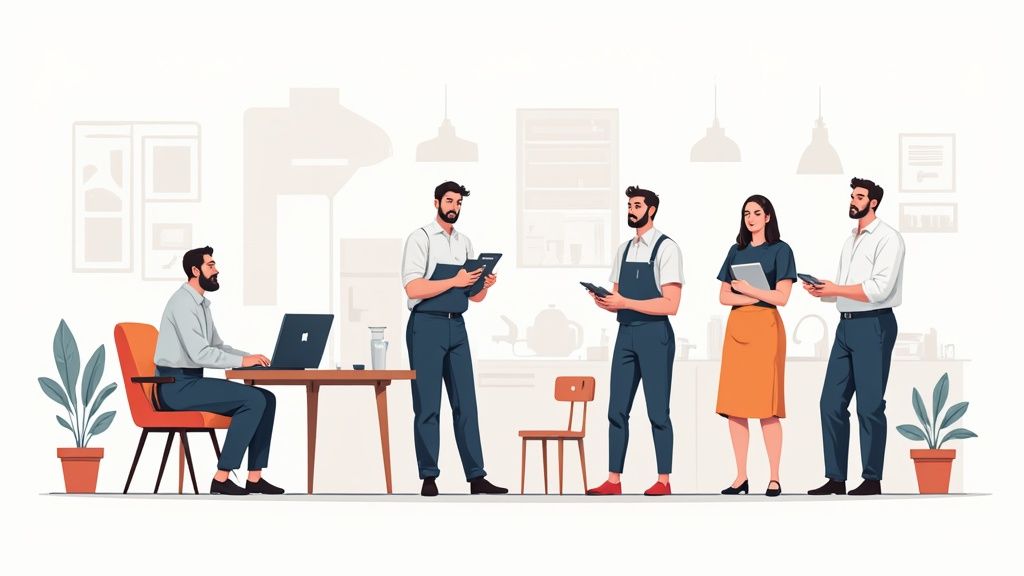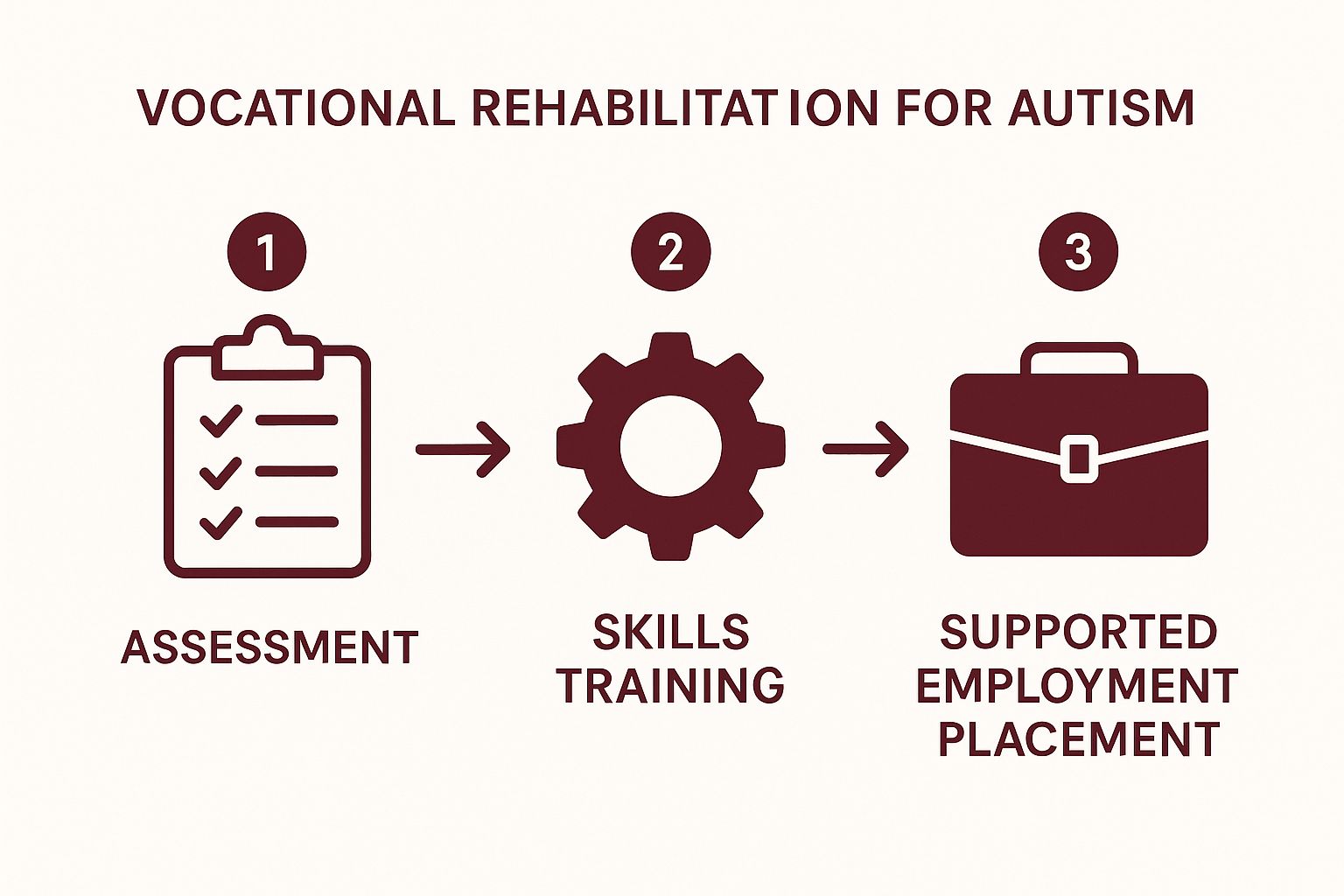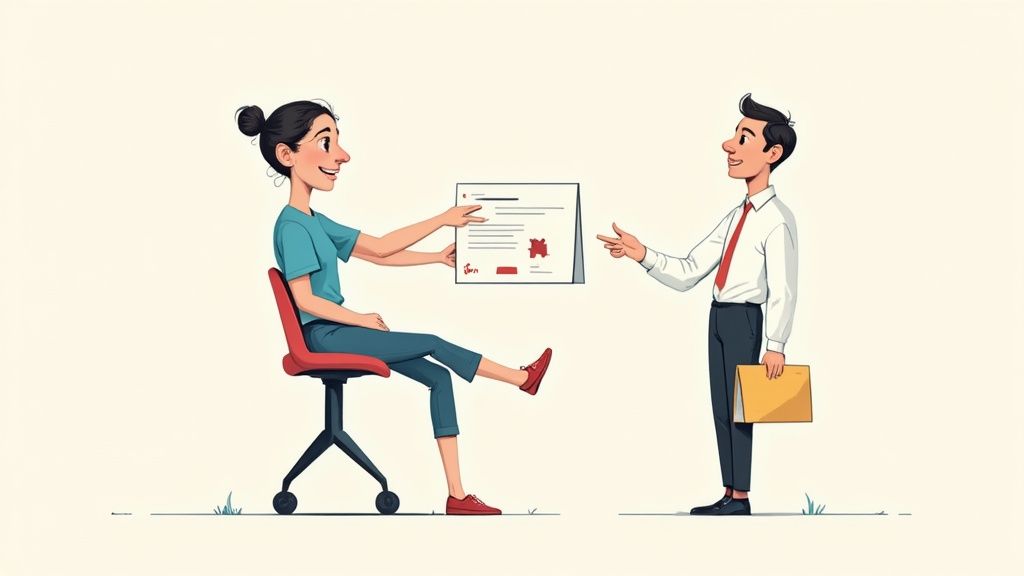Think of vocational rehabilitation for autism as something more than just a program—it's a personalized partnership. It’s like having a dedicated launchpad designed to help an autistic person not just land a job, but build a career that truly fits their unique talents and passions. The whole point is to provide the right tools, training, and support to clear away employment hurdles and pave the way for long-term success.
Your Career Co-Pilot for Navigating the Workplace
Vocational Rehabilitation, or VR, is so much more than a simple job placement service. It's better to think of it as having a career co-pilot. You're still the one flying the plane and steering your own career path. But the VR counselor is right there beside you, helping you read the maps, navigate any turbulence, and chart the best course to your destination: a fulfilling, sustainable career.
This entire partnership is grounded in what we call person-centered planning. It goes way beyond the basic question, "What job can you do?" Instead, it starts with much deeper, more meaningful questions, like:
- What are you genuinely passionate about? What are your interests?
- What are your specific strengths and unique talents?
- In what kind of environment would you truly thrive?
- What are your long-term dreams for your career?
More Than Just a Job Search
The real mission of vocational rehabilitation is to dismantle the barriers that often make finding and keeping a job so tough for autistic individuals. It’s a proactive and supportive system designed to build real skills and confidence, not just to polish up a resume. This process recognizes that the right kind of support can make all the difference in the world.
Vocational rehabilitation is about equipping individuals with the specific skills and strategies they need, not just for the interview, but for the first day on the job and every day after. It's a bridge from potential to performance.
The need for this kind of tailored support is undeniable. Statistics show that about 50% of autistic youth in the United States get VR services as they move into adulthood. And while around 80% of eligible autistic individuals sign up for job training, only about half of them successfully find employment afterward. You can read the full report on these employment figures on Autismspeaks.org to get more insight. This gap highlights just how crucial that individualized support from VR is in helping improve those outcomes.
Core Components of Vocational Rehabilitation
At its heart, VR is a collection of services tailored to the individual. While every plan is unique, they are all built from a set of core components designed to address common challenges and build on personal strengths.
Here's a breakdown of what that typically looks like:
| Service Area | Description | Example for an Autistic Individual |
|---|---|---|
| Assessment & Counseling | A deep dive into an individual's strengths, interests, skills, and support needs to create a personalized employment plan. | A counselor helps a young adult identify that their deep interest in patterns and logical systems makes them a great fit for data analysis or software testing. |
| Career Exploration | Hands-on experiences like job shadowing or informational interviews to explore different career paths in a low-pressure setting. | Trying a one-day work experience at a local library to see if a quiet, organized environment is a good match before committing to a job. |
| Skills Training | Specific training to develop "hard" skills for a job (like using specific software) or "soft" skills for the workplace (like communication). | Participating in a workshop on understanding workplace social cues or taking a course to become certified in a specific coding language. |
| Job Placement & Coaching | Active support in searching for jobs, preparing for interviews, and on-the-job coaching to help with the transition into a new role. | A job coach might attend the first few days of work with the individual to help them understand tasks and navigate the new social environment. |
| Assistive Technology | Providing tools and technology that can help an individual perform their job more effectively. | Supplying noise-canceling headphones for a noisy office or specialized software that helps with organization and time management. |
These services work together to create a comprehensive support system, ensuring that every angle of the employment journey is covered.
Building a Foundation for Success
Ultimately, the goal of VR is to foster independence and empowerment. By working closely with a counselor, an autistic person can learn to identify their own unique skill sets and figure out how to best present them to potential employers.
It's a comprehensive approach that ensures individuals aren't just dropped into a job. They are truly prepared to succeed, grow, and build a meaningful professional life on their own terms.
Navigating the VR Eligibility Process
Trying to figure out if you qualify for vocational rehabilitation (VR) can feel like solving a puzzle when you don't have all the pieces. The language can be confusing, and the rules might seem unclear at first glance. But once you grasp the core ideas, the path forward becomes much clearer.
At its heart, eligibility for VR services for autism comes down to two main points. First, you need a documented disability. Second, you have to show that this disability creates a real roadblock to getting, keeping, or moving up in a job.
This is a crucial distinction. It’s not simply about having an autism diagnosis. It’s about connecting the dots for the VR agency, showing them how specific challenges—like difficulties with social communication, sensory sensitivities, or executive functioning—directly impact your ability to succeed at work.
The Core Eligibility Checklist
To be approved for VR services, there are a few key boxes you’ll need to tick. The exact wording might change a bit from state to state, but the fundamental requirements are consistent everywhere.
You are generally eligible if:
- You have a documented disability. This can be a physical, mental, emotional, or cognitive condition. In this case, it would be your formal autism diagnosis.
- Your disability is a barrier to employment. This is what’s officially called a substantial impediment to employment. It means your autism presents genuine challenges in a work setting.
- You require VR services to succeed. You need the specific kinds of help VR provides—like job coaching, skills training, or career counseling—to get ready for, find, or hold onto a job.
The real aim here is to demonstrate that with the right support from VR, you have a great chance of achieving your employment goals. It’s all about building a case for your potential, not just listing your limitations.
Preparing for Your First Meeting
After you reach out to your local VR office, they’ll set up an initial meeting with a counselor. A little preparation can make this appointment go much more smoothly. You’ll be asked for information about your disability, your education, and any jobs or volunteer roles you’ve had.
To get ready, it’s a good idea to gather:
- Diagnostic Documentation: Bring any reports or letters from professionals that confirm your autism diagnosis.
- School Records: Things like IEPs (Individualized Education Programs) or 504 plans are incredibly helpful because they already document your support needs.
- Work History: A simple list of past jobs is perfect, even if they were short-term.
The counselor's job is to work with you, and showing up prepared helps them get a complete picture of your situation right from the start. This teamwork is key to creating a successful plan that truly supports your career goals. This foundation also helps set expectations for future employers; you can learn more about creating inclusive work environments for autistic individuals to see how this early preparation really pays off.
Your Personalized Journey Through VR
Vocational rehabilitation isn't a rigid, one-size-fits-all program. Far from it. Think of it as a highly personalized journey that you help design from the ground up. It’s less like filling out a standard application and more like a collaboration, where every step is built around your unique skills, interests, and goals.
The whole process starts with a comprehensive assessment. This isn't a test with right or wrong answers. Instead, it’s a discovery phase where you and your counselor really dig into your strengths, passions, and the specific kinds of support that would help you thrive in the workplace.
Crafting Your Career Roadmap
After the assessment, you and your counselor will create an Individualized Plan for Employment (IPE). This document is the cornerstone of your entire VR experience. It's a formal roadmap you build together, detailing your specific career goals and outlining the exact services the VR agency will provide to help you get there.
The IPE makes sure everyone is on the same page and that your path forward is clear. It’s also a living document—it can be adjusted as you progress, making it a flexible tool for your career development.
To see how this works in the real world, let's follow the story of a young adult named Alex.
A Real-World Example: Alex's Journey
Alex is a talented graphic designer with a passion for digital art, but he finds the fast-paced and unpredictable nature of job interviews incredibly stressful. During his VR assessment, he and his counselor pinpointed his exceptional attention to detail and creative skills as major strengths. They also recognized that his challenges with social communication and sensory overload in busy settings were significant barriers to finding a job.Together, they built an IPE with a clear goal: to land a junior graphic design position at a small, structured agency. The plan outlined several key services to help him make it happen.
The infographic below breaks down the three core phases of a typical VR journey, much like the one Alex is on.
As you can see, each stage builds on the last, creating a structured pathway from initial planning all the way to active employment.
Bringing the Plan to Life
With the IPE in place, the plan became a reality. Alex started receiving the support outlined in his roadmap. His journey included:
- Specialized Training: He enrolled in a VR-funded workshop focused on building a professional portfolio and practicing interview skills in a supportive, one-on-one setting.
- Assistive Technology: The VR agency provided him with high-quality, noise-canceling headphones to help manage sensory input during his job search and, eventually, at work.
- Strategic Job Placement: His counselor connected him with employers who truly valued neurodiversity and were specifically looking for the detail-oriented skills Alex possessed.
This personalized support system completely changed Alex's job search. Instead of feeling overwhelmed, he felt prepared and confident. A personalized VR journey can even provide practical guidance on changing careers if you're looking to start a new chapter, offering the structure to explore different fields.
In the end, Alex landed a role that was a perfect fit—not just for his skills, but for his support needs, too. This story shows how vocational rehabilitation for autism, when built around individual strengths, creates a clear and effective path to meaningful employment.
Essential Support Services for Autistic Individuals
What makes vocational rehabilitation so effective for the autistic community? It’s not about just checking boxes for generic employment goals. The real magic is in the highly customized support systems designed to bridge the gap between an individual's unique potential and their professional success.
At the very heart of this support network is job coaching. Don't think of a job coach as a boss or a supervisor. A better way to see them is as an on-site mentor. Their role is to help a new employee learn the technical side of their job while also learning to navigate the unwritten rules and social dynamics of a specific workplace. This direct, hands-on guidance is often the key to a smooth transition.
For instance, a job coach might sit with a new autistic software developer and help them break a massive project down into smaller, more manageable daily tasks. They could also role-play different ways to ask a manager for help or how to contribute during a team meeting, building confidence for real-world scenarios.
Building Skills for Workplace Success
Beyond the immediate on-site coaching, many VR programs also provide focused training to build the foundational skills someone needs for long-term career growth. These services are all about empowering individuals with the tools to work independently and effectively.
Some of the most critical training areas include:
- Targeted Social Skills Training: This is much more than basic manners. It focuses on practical workplace communication, like understanding how to take turns speaking in a meeting, interpreting non-verbal cues from coworkers, or navigating networking events. You can learn more about developing these abilities in our guide to https://sachscenter.com/social-skills-for-autistic-adults/.
- Executive Functioning Support: Many people, neurodivergent or not, can benefit from strategies to better manage their time, organize tasks, and stay focused. A VR specialist might help someone set up a digital calendar system or use project management apps to keep track of multiple deadlines.
- Self-Advocacy Training: Learning how to clearly state your needs and request reasonable accommodations is a vital part of professional development. This training helps individuals feel comfortable and prepared to have those important conversations with employers.
This layered approach ensures that support is not just about finding a job, but about creating the conditions to thrive in that job. The focus is on building a sustainable career path, not just getting a foot in the door.
The Role of Assistive Technology
Assistive technology (AT) can be a complete game-changer, offering simple, practical solutions to common workplace challenges. VR programs often include an assessment of an individual’s needs to connect them with tools that level the playing field.
For an autistic individual, this could mean things like:
- Noise-canceling headphones to manage sensory overload in a loud, open-plan office.
- Speech-to-text software to make drafting emails or long reports less draining.
- Visual schedule apps to provide a clear, predictable structure to the workday.
These aren't crutches; they are powerful productivity tools that allow a person’s true skills to shine.
On top of these personalized supports, VR almost always includes job readiness preparation. Creating a professional resume is a core step, and many find it helpful to use tools like comprehensive resume builders to organize and present their skills effectively. By combining personal coaching, skills training, and the right technology, vocational rehabilitation creates a powerful, personalized launchpad for success.
Unlocking Potential with Vocational Rehabilitation
When we talk about the success of vocational rehabilitation for autism, it's easy to focus on a new job title or a steady paycheck. But the real story is much bigger. The benefits ripple outward, touching every part of an individual’s life. This process is about so much more than just employment; it's a powerful way to foster personal growth, independence, and self-discovery.
Think about it: when an autistic person finds meaningful work that truly clicks with their skills and passions, it often sparks a profound shift in self-esteem. Hitting career goals builds a sense of competence and purpose that can completely reshape how they see themselves and their place in the world.
This journey also builds crucial life skills. Learning to handle workplace responsibilities and work alongside colleagues strengthens self-advocacy. Individuals get better at articulating their needs, understanding their strengths, and asking for the support they need to thrive—skills that are priceless in every area of life.
More Than a Paycheck: A Community and Purpose
While financial independence is a huge win, the social and emotional rewards are just as important. A good workplace can become a community, offering a sense of belonging that helps reduce the social isolation many autistic adults face. It provides a structured, predictable place to build relationships and feel like part of a team.
The need for these kinds of supportive pathways is only getting more urgent. Globally, autism prevalence has risen dramatically, with recent data showing about 1 in 31 children are now diagnosed as autistic. As this generation of autistic youth grows into adulthood, the demand for effective vocational rehabilitation and transition programs is more critical than ever. You can explore more about these autism prevalence statistics on AbacusTherapies.com.
A Win-Win for Employers
The great news is that the benefits don't stop with the individual. Employers who lean into these programs also see incredible advantages. By partnering with VR, companies get access to a dedicated, skilled, and often completely overlooked talent pool. It's common for autistic employees to bring exceptional focus, deep loyalty, and a fresh perspective to their roles.
Tapping into this talent isn't just a diversity initiative—it's a smart business decision that enriches company culture and drives innovation.
Creating an inclusive workplace just makes the entire environment better for everyone. When a company truly invests in the success of its neurodivergent employees, it sends a powerful message about its commitment to genuine inclusion. Of course, putting the right support in place is key, and it’s helpful to understand what effective autism workplace accommodations actually look like.
Ultimately, vocational rehabilitation is about unlocking human potential, creating a more capable, diverse, and innovative workforce for the future.
Your Top Vocational Rehabilitation Questions, Answered
Stepping into a new system like vocational rehabilitation always brings up questions. When you're looking into VR for autism, it's completely normal to wonder about the nitty-gritty details. We've gathered some of the most common questions here to give you clear, straightforward answers and help you see the path forward.
Remember, this process is meant to be a supportive one. Asking questions is the best way to start, as being informed makes you a powerful advocate for yourself or your loved one.
How Do I Find My State's Vocational Rehabilitation Agency?
Every single U.S. state and territory has its own VR agency, and finding yours is usually pretty simple. The fastest way is to pull up a search engine and type in “[Your State Name] Vocational Rehabilitation Services.” This almost always takes you straight to their official website.
If you'd rather use a directory, the federal Rehabilitation Services Administration (RSA) keeps a national list of all state VR agencies. Most state agencies also have local offices, so you can easily find one that serves your specific town, city, or county.
Can I Get VR Services If I'm Already Employed?
Yes, absolutely. It's a common misconception that vocational rehabilitation is only for people who are unemployed. You might still be eligible for support in a few different situations.
For instance, you could be considered "underemployed." This means you’re working in a job that doesn't really use your skills and qualifications, or maybe you're stuck in a part-time role when you need full-time work. You might also qualify if your disability puts you at risk of losing your current job.
The goal is always to find sustainable, meaningful employment. VR can provide job retention services, help you seek a promotion or advance your career, or assist you in finding a new role that’s a much better match for your unique strengths.
What’s the Difference Between VR and the Ticket to Work Program?
While both programs want to help people with disabilities find and keep a job, they work quite differently. Knowing how they differ can help you figure out which path makes the most sense for you.
Here’s a quick breakdown:
- State Vocational Rehabilitation (VR): Think of these as state-run agencies offering a wide range of direct, hands-on services. This can be anything from one-on-one career counseling and assessments to funding for specialized training or providing an on-the-job coach.
- Ticket to Work Program: This is a federal program for people who receive Social Security disability benefits (SSI or SSDI). It’s completely voluntary and lets you assign your "ticket" to an approved provider, called an Employment Network (EN), which then offers employment support.
It's also worth noting that many state VR agencies double as Employment Networks. In some cases, you can even use both programs together to build an even stronger support system.
At the Sachs Center, we know that a formal diagnosis is often the key that unlocks essential support like vocational rehabilitation. Our specialized telehealth evaluations for Autism and ADHD provide the diagnostic clarity needed to secure workplace accommodations and build a path toward a fulfilling career. If you're ready to gain a deeper understanding of your neurotype, book your evaluation with the Sachs Center today.



